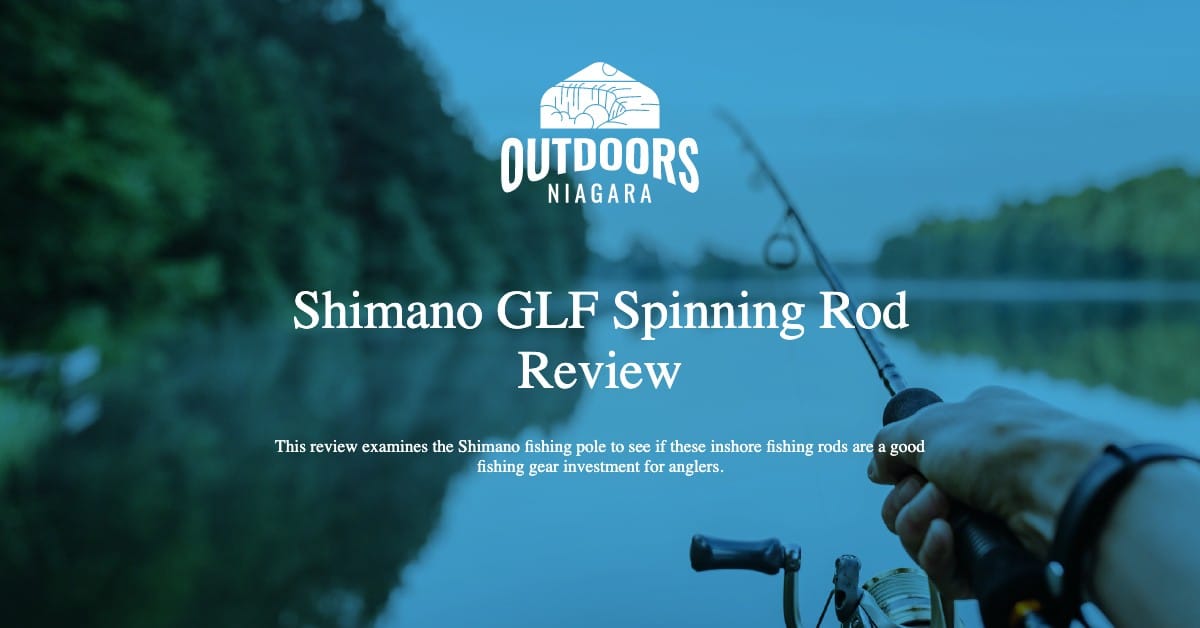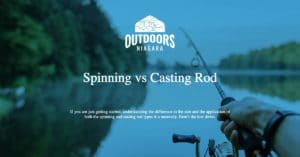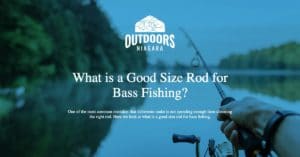The Shimano GLF Gulf Coast Spinning Rod Models are part of a family of products with a high-graphite-content blank offering anglers an exceptional build.
Thanks to the combination of different materials, these inshore spinning models buck the correlation between rod price and quality by providing far more value than expected.
However, the saltwater fishing gear Shimano spinning rods aren’t exactly inexpensive models, though neither are they the most expensive either.
That’s why this review examines the Shimano fishing pole to see if these inshore fishing rods are a good fishing gear investment for experienced anglers or just another gimmick.
Contents
Pros
- Is smoother casting
- 30-ton hybrid blanks
- Plenty of backbone
Cons
- Not the cheapest
- Not many length options
- Only fast action models
Review
Construction (craftsmanship, make quality)
When comparing the Shimano GLF to other inshore spinning rods, the first thing that immediately stands out is the carbon blank.
Rather than go with a 30-ton 100 percent graphite blank, the GLF series casting spinning rods employ a 30-ton lightweight hybrid blank that threads in 24-ton carbon fiber graphite to create some of the most balanced blanks available.
Keep in mind that most of the time you see a hybrid blank design, it incorporates fiberglass into the carbon fiber threads to reinforce its durability.
However, fiberglass, as durable as it is, doesn’t translate vibration nearly as well as carbon fiber which ultimately reduces those hybrid blanks’ sensitivity in favor of strength.
However, the Shimano GLF blank simply substitutes one type of carbon fiber thread for another, significantly reducing the decrease in sensitivity.
Granted, while this design means these saltwater rods aren’t quite as sensitive as they could be, the additional flex that the 24-ton carbon-graphite fibers afford more than makes up for the loss.
Beyond the blank, these super light fishing poles also come with a titanium-oxide semi-micro guide train that uses smaller rings than you’re liable to find on too many other rods– regardless of their intended use.
While the material chosen allows these spinning rods to enhance their casting ease, this build design further increases this benefit.
Continuing with the GLF’s hybrid approach, this series trades the full-cork grips you expect to find on mid-tier and up models and utilizes two different grip materials instead.
These spinning poles provide comfortable cork mid grips but pair that with high-density EVA foam rear grips for an ergonomic design that helps ensure all-day comfort.
Length
The only thing to note about the Shimano GLF’s length is that it doesn’t deviate too much from the average, suggesting that this lineup is meant to be more of a generalist rod.
However, one of the more surprising aspects of these rods’ length is that none of the poles, whether 6’6″, 7′ or 7’6″, come in 2-piece models.
This means you’ll need a vehicle that can accommodate this length if you plan on driving to your fishing spot.
And, considering this spinner series bills itself as a “Gulf Coast” lineup, that likely includes the majority of its owners.
Material
While the hybrid 30-ton carbon blanks might seem fairly straightforward, this decision has impacts on these graphite fishing rods that reverberate throughout the pole.
For starters, the 30-ton graphite fibers used are exceptionally sensitive and transfer more vibrations than most– though they are a bit brittle too.
Conversely, the 24-ton graphite fiber threads, which are also known as “high-modulus graphite,” don’t transfer vibrations quite as well but are far more flexible and durable than intermediate or low-modulus graphite.
The incorporation of these two fibers provides a light weight blend where the different graphite weights complement each other perfectly, reinforcing what the other lacks.
Of course, we see this trend play out a second time when it comes to the handle, despite the absence of a nonslip grip finish.
Regardless, the fact that this pole uses two different materials for the handle means the grip material action provides different qualities to the rear and foregrips, favoring strength to the fore and comfort to the rear.
The use of aluminum-oxide or titanium-oxide for the guides, however, doesn’t follow this approach and instead depends more on which version you get.
Still, both of these materials afford similar benefits when casting your line– though which lines they can and cannot cast differ depending on which model you get.
Action
The GLF spin casting poles only come in fast action models which can be a bit frustrating for some inshore fishermen, especially those that take to the water in a boat.
However, the fast action comes with plenty of advantages with accurate casts being the most notable and extremely important to coastal inshore fishing.
Granted, a fast action is not ideal to get monster casting distances, but this decision also increases the GLF’s already impressive sensitivity.
It’s also worth remembering that, with no truly “short” models and multiple rods that are 7′ or longer, you shouldn’t have too much difficulty with distance casting anyway.
Power
These rods all hover around the medium power rating which means you should likely target fish of average weight.
That said, the fishing power of a rod is not meant to be a substitute for the rod’s durability, so trying to lift a fish out of the water by the pole alone, unaided by a net or other tool, is not advisable.
Still, the GLF spinning pole gives you a little bit of wiggle room with medium-light and medium-heavy power settings available.
Rod Guides
Depending on the version you get, these spinner rods can come equipped with either titanium-oxide guides or aluminum-oxide guides.
While both of these designs provide the same kind of casting ease concerning tangles and distance, only the titanium-oxide guides are capable of handling a full day of fishing with braided lines.
Granted, most people using braided lines would look for something focused on durability like Alps 316 stainless-steel guides.
However, the Shimano GLF’s deep-pressed titanium guides are more than strong enough to handle braided lines with heavier spin casting lures while still preventing tangles during the cast.
Handle (material, shape, etc)
By now, you already know that the split-grip GLF rods use two different materials, but the combination of a cushion cork grip with high-density EVA foam for the rear serves more nuanced purposes than you might expect.
While the cork isn’t properly a non-slip grip, it still affords a solid handhold both for technique and fighting fish.
It might seem like the absence of a non-slip grip wouldn’t work as well when fighting aggressive fish, but this is where the but comes into play.
Since most of your leverage is generated by the butt of the blank, it’s important that you can “dig” and set a firm anchor with the handle.
The foam reargrip allows you to do this more comfortably and thus more effectively.
One thing to keep in mind is that the foregrip length actually runs a bit short, especially if you’re someone with larger hands.
However, a competitive angler understands that this design forces you to keep some of your hand on the rod blank at all times, allowing you to get a better feel for even gentle nibbles from skittish fish.
Uses (Who is this good for)
While these Shimano fishing rods tend to come in a medium-power, fast-action blank, inshore anglers looking for the right fishing equipment to take with them on their next Gulf Coast fishing trip shouldn’t have any trouble finding the right spec configuration.
That said, this isn’t really the rod to go after soft-mouthed species.
Regardless, these spin casting rods afford an array of fishing techniques for everything from flats fishing to pier fishing to even bass fishing.
Even better, these classic casting spinning rods have other quality of life features like their dual-material handles to make using this fishing pole all day as comfortable as possible without sacrificing quality.
On the other hand, while not on the high end of the mid-tier price range, the GLF doesn’t come in at a budget-friendly price either.
As such, this may not be the best option for an absolute neophyte who isn’t even properly invested in the sport yet, but it can be a great early rod for a beginner who’s ready to take the next step, upping their gear and fishing game.
Reel and Real Seat Compatibility
The Shimano GLF uses a custom reel seat, though this is not terribly different than any other number of Shimano fishing poles from their bargain-basement models to their tournament-grade options.
While the reel seat was designed for use with Shimano series reels, they still generally work well with most properly-sized spinning reels.
Regardless, this custom reel seat sees a skeleton reel seat design combined with a carbon fiber graphite build.
While the reel seat may require some care during assembly, you shouldn’t have to worry about its durability, and the already impressive sensitivity provided by the blank sees further reinforcement from the graphite reel seat.
Conclusion (Wrap Up)
In the end, the Shimano GLF spinning fishing pole doesn’t provide the tournament-grade performance that competitive anglers crave– but neither does it come with a professional-level price tag either.
Instead, this spinner casting rod aims to find the balance between strength and performance with an uncommon pairing of generally exclusive materials.
With a blank that features two different tonnages of carbon graphite fibers, you can expect a pole that’s both sensitive as well as strong.
And that solid backbone only sees further reinforcement with the use of a cork foregrip for traction and a foam reargrip for comfort, allowing you to apply pressure and leverage without fatigue for all-day fishing.







